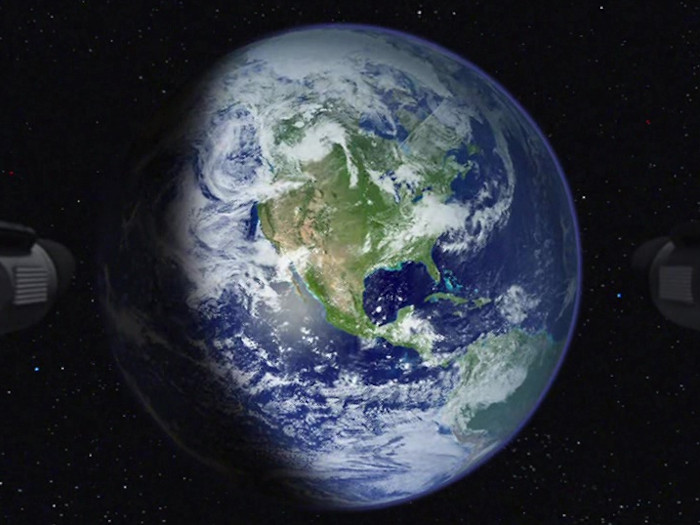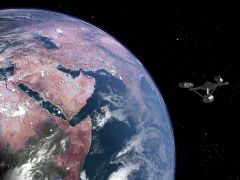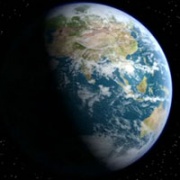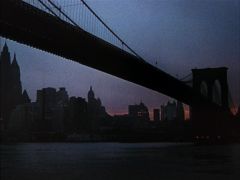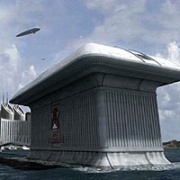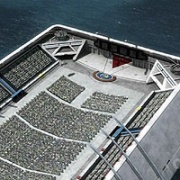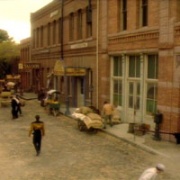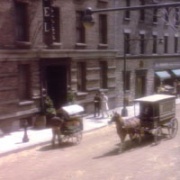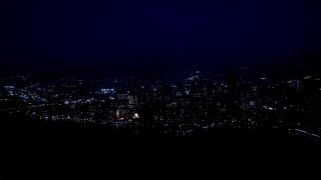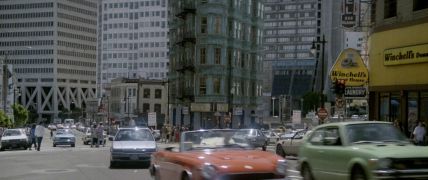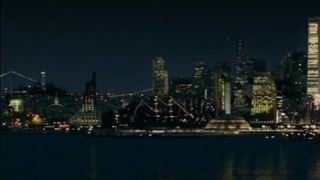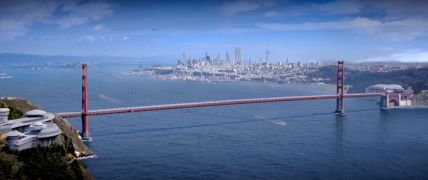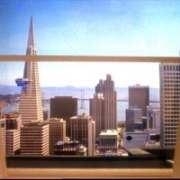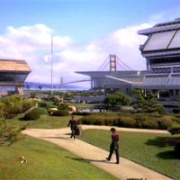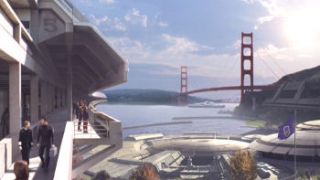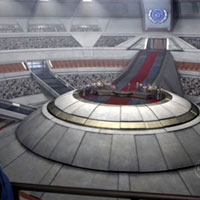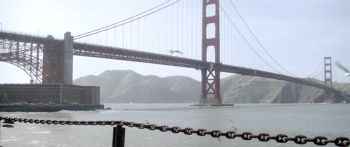Earth
| Official Name | United Earth Republic[1][2][3] (founded 2130)[4] |
| Affiliation | United Federation of Planets[5] |
| Distance from Star | 1 AU; 149,680,000km[2] |
| Orbital Period | 365.24 days[2] |
| Rotational Period | 24 hours[2] |
| Class | M[5][2] |
| Surface Temperature | -56.7°C to 34°C[2] |
| Diameter | 12,756km[2] |
| Gravity | 1.0g[1][2][3] |
| Natural Satellites | Luna[5] |
| Points of Interest | Earth Spacedock,[6] Earth Station McKinley,[7] San Francisco,[8] San Francisco Fleet Yards,[5] Starfleet Academy,[9] Starfleet Command[10] |
| Notable Species | Humans,[5] Cetaceans[8][2] |
| Notable Individuals | Jonathan Archer,[1] Zefram Cochrane,[11] Kathryn Janeway,[12] James T. Kirk,[9] Jean-Luc Picard,[13] Christopher Pike,[5] Khan Noonien Singh,[14] Benjamin Sisko[15] |
| Notable Events | World War II,[16] Eugenics Wars,[17] World War III[18] |
| First Appearance | • Mentioned: TOS 05 (8 Sep 1966) • Appeared: TOS 21 (26 Jan 1967) |
| Advertising |
|
Earth, the homeworld of the Human species,[5] is the third planet in the Sol system,[5] located in the Sol Sector[2] (aka Sector 001),[19] in the Alpha Quadrant.[2] The planet draws its name from the Hebrew word erets, which means "dirt" or "soil," as the planet was the very ground on which Humans walked.[20] The United Earth Republic, founded in 2130,[4] co-founded the United Federation of Planets in 2161,[21][22] following the end of the Romulan War,[23] and the planet served as that nation's capital.[8] Earth was widely regarded as the nerve center of the United Federation of Planets.[3] In 2254, the Talosians viewed an image of the Sol system and many images of Earth’s history while accessing the U.S.S. Enterprise' NCC-1701's computer.[5]
New York City, 1930 (TOS 28)
New York City, 1966 (TOS 55)
San Francisco Bay Stadium, 2154 (ENT 79)
San Francisco Bay Stadium, 2154 (ENT 79)
San Francisco, 1893 (TNG 226)
San Francisco, 1893 (TNG 227)
San Francisco, 1986 (Star Trek IV)
San Francisco, 1986 (Star Trek IV)
San Francisco, 2151 (ENT 01-02)
San Francisco, 2372[24]
Starfleet Academy, 2368 (TNG 219)
Starfleet Command, 2151 (ENT 14)
Starfleet Command, c.2285 (Star Trek IV)
Environment and Geography
A Class M planet,[5] Earth has a highly varied climate, and the planet—from the interiors of volcanoes to the bottoms of its oceans—teems with life.[3] Temperatures in the polar zones rarely rise above freezing and are inhospitable to life, and the sub-arctic zones, while also hostile to most life forms, are nevertheless home to very hardy plants and small animals; temperatures around the equator are often too hot for comfortable Human habitation during the summer months. The majority of Humans live in the planet's sub-tropical belts.[25] Large portions of the planet remain off-limits to further development as conservation zones or wilderness parks.[3][26]
Earth's landmass is divided into seven continents: Africa, Antarctica, Asia, Australia/Oceana, Europe, North America, and South America. Antarctica covers the planet's South Pole, and while heavily mined for natural resources, it has few permanent inhabitants, due to its harsh climate. North America, Europe, and Asia are heavily industrialized. Mount Everest, the highest point on the planet, is located in Asia.[25]
Earth's hydrosphere is divided into seven major bodies: the Arctic Ocean, the Arabian Sea, the Atlantic Ocean, the Caribbean Sea, the Indian Ocean, the Mediterranean Sea, and the Pacific Ocean. The Arctic Ocean covers the North Pole and is largely covered with a thick ice cap.[25] There is a significant amount of water on the planet, with 78% of the surface being covered with it,[3] making Earth very nearly a Class O planet (80% or more of the surface being liquid water).[2] The Pacific Ocean is the largest body of water on Earth; it divides the continent of Asia from the Americas, and completely surrounds Australia and the islands of Oceana. The lowest point on the planet, the Marianas Trench, is also located in the middle of the Pacific Ocean.[25]
Humans spent centuries working to restore the planet's damaged ecosystems and to restore lost species. This became even more urgent following the destruction wrought by the planet's Third World War. Weather control probes and oceanic fertilization programs helped to restore the planet to its prewar state,[3] and although the reintroduction of humpback whales—belatedly determined to be a sapient species—via time travel in the 2280s[8] was a dramatic example, genetic reconstruction programs restored thousands of extinct species, including the passenger pigeon, the great auk, the Bengal tiger, and the white rhinoceros.[3]
History
The history of Human civilization on Earth could be described as "a chronicle of failed attempts to get along with itself until, at last, humanity got it right."[25] From the beginning, Human ideals were forged and defended in conflict, and the seeds of the ideals upon which the Federation was founded could be found in the wars of the fifth century B.C.E., in the wars between the Greek city states and the Persian Empire.[3]
The twentieth century saw both democracy and despotism, and the conflicts between the two proved calamitous on a global scale.[16][3][25] Two world wars resulted in hundreds of millions of deaths, both military and civilian, as well as the advent of weapons based upon nuclear fission.[16][25] Following the Second World War, the United Nations was formed, but it ultimately failed, as it had no real power to curb member nations' sovereign rights, and it had little influence over private interests.[25] As the century drew to a close, this was made dramatically clear when the Chrysalis Project,[27] a privately-funded team of scientists, used highly advanced genetic engineering techniques to produce the Augments,[28] a group of modified Humans who were superior to the species norm.[14] In a series of coups, they quietly and anonymously[29][25] seized power in 40 nations.[14] The most powerful of the Augments, Khan Noonien Singh, secretly reigned over a quarter of the planet's population at the height of his power.[14][29] The Augments soon fell out with one another, and conducted a series of internecine conflicts among themselves that, as a whole, were known as the Eugenics Wars.[14][28] In 1996, Khan and more than 80 of his Augment followers were forced to flee the planet,[14] seizing a classified, experimental spacecraft, the DY-100 class, which they dubbed the S.S. Botany Bay, from a secret military facility in the Nevada desert.[29] The century ended on a note of optimism, with the ground-breaking ceremonies for the Millennium Gate,[30] as well as one of humanity's first attempts to travel into deep space. In 1999, philanthropist Optimo Basilius sponsored a project that took 2000 volunteer colonists from the United States of America and the People's Republic of China, and sent them into deep space. Contact was lost more than 50 years later, however, and their fate remained a mystery for more than two centuries.[25]
The conflicts and strife of the twentieth century carred over into the twenty-first, however, but the first inklings of a better future began in 2028, with the humanitarian reforms to the Sanctuary Districts that followed in the wake of the Bell Riots.[31][32] On 1 May 2053,[33] the Third World War broke out, with nuclear strikes devastating much of the planet.[18] Most contemporary accounts of the period were lost, and the historical record of the era remained fragmentary.[14][18] More than 600 million died in the brief war, and humanity was plunged into another dark age, with advanced civilization surviving only in pockets.[18] The Postatomic Horror gripped much of the planet, and some areas saw a return to barbaric "courts" where guilt or innocence was less important than the entertainment of the masses, and military forces were controlled by the use of narcotics.[13] In 2063, however, Zefram Cochrane and his assistant, Lily Sloane developed Earth's first warp drive engine from a modified Titan V rocket. On 5 April 2063, the first flight of the ship, the Phoenix, caught the attention of a passing Vulcan ship,[18] the T'Plana Hath.[34] The Vulcans initiated first contact, marking the first formal contact between Humans and an extraterrestrial species.[18] (Prior contacts with Vulcans,[35] Ferengi,[36] and Devidians,[37][38] among others, were all cloaked in secrecy or unnoticed by Humans of the time).
First contact forced a radical shift in how Humans viewed themselves, and their place in the galaxy.[18] With the assistance of the Vulcans, Humans began the process of repairing the damage to Earth wrought by nuclear war. Over the course of the next century, the scourges of poverty, disease, and war were eventually eradicated.[18] The United Earth government was formed in 2130,[4] with Australia being the last country to join in 2150.[39][40] Technology continued to advance, although the Vulcans refused to simply give Humans the technologies that the Vulcans had already developed, preferring to prompt the younger species to develop the technologies on their own, much to humanity's growing frustration.[1] In 2145, Emory Erickson invented the first functional transporter,[41] which in 2151 was certified safe for transporting living organisms.[1] Also in 2151, during humanity's first contact with Klingons, the Enterprise NX-01, the first Human-built craft capable of reaching warp 5, launched from the San Francisco Fleet Yards.[1] A year later, the Enterprise made first contact with the Romulan Star Empire. By 2155, humanity had brokered peace agreements between several of its neighbors—notably the Vulcans, Andorians, and Tellarites—and had laid the groundwork for the Coalition of Planets, an alliance between humanity and those three powers.[42][43] The Romulan Empire felt threatened by such a potentially powerful alliance on its border, and began to take steps to disrupt the Coalition before it could even be formed.[42][44][45] Within a year, the Coalition was at war with the Romulans, but the damage had been done. The Romulans had a weapon that enabled them to remotely take control of Coalition ships, to which non-Human ships were more susceptible. The Coalition began to splinter, and Earth soon found itself facing the Romulans with only meager support from its Coalition partners.[46][47][48] The war ended after Human forces inflicted a decisive defeat at the Battle of Cheron.[23][48] An armistice was negotiated over subspace radio, and a neutral zone was established between the Empire and what later became Federation space.[49] In 2161, following the conclusion of the Romulan War, delegations from Earth, Andoria, Vulcan, Tellar Prime, and Alpha Centauri met on Earth and drafted the conventions that founded the United Federation of Planets.[22][48]
Earth enjoys one of the most advanced, peaceful, and materially pleasant cultures of any known species. There was no case of terrorist bombing or a State of Emergency, other than the Borg attack of 2366, reported in over a century prior to the Antwerp Conference incident and the Changeling scare of 2372.[50] Its worldwide power-relay system is run by the Division of Planetary Operations to operate sensors, transporters and surface-based defense installations. Starfleet also has its own emergency back-up system.[51]
Government
The United Earth Republic was born from a union of the United States of America and the European Hegemony[3] in 2130,[4] resulting in a structure that combined both the European parliamentary system and North American federalism.[3][52][47] Although the pre-existing national governments continued to exist, they were, from that point forward, more akin to the state governments under the United States.[3] The head of state of the United Earth is the office of the President of the United Earth Republic,[47] while the head of the government is the Prime Minister.[52] Australia joined the United Earth Republic in 2150, and it was the last country to do so.[39][40]
Points of Interest
- Asia:
- Australia/Oceana:
- Europe:
- North America:
- Alaska: Bering Sea, Earth Station McKinley
- Canada: Calgary
- California: Alameda, Chronowerx, Fusion Club, Griffith Observatory, Los Angeles, Marin County Ship Yards, Mojave, San Francisco, San Francisco Fleet Yards, Starfleet Academy, Starfleet Command
- Florida
- Louisiana: Audubon Park
- Michigan: Detroit
- New York: New York City
- Oklahoma: Broken Bow
- Pennsylvania: Carbon Creek
- Washington, D.C.: White House
- South America:
Notes and References
- ↑ Jump up to: 1.0 1.1 1.2 1.3 1.4 1.5 "Broken Bow." Enterprise, Episodes 1-2. Television. 26 September 2001.
- ↑ Jump up to: 2.00 2.01 2.02 2.03 2.04 2.05 2.06 2.07 2.08 2.09 2.10 2.11 Mandel, Geoffrey. Star Trek: Star Charts. Pocket Books, 2002.
- ↑ Jump up to: 3.00 3.01 3.02 3.03 3.04 3.05 3.06 3.07 3.08 3.09 3.10 3.11 3.12 Isaacs, Ross A. (Line Developer). Planets of the UFP: A Guide to Federation Worlds. Star Trek: The Next Generation Roleplaying Game. LUG Book 25102. Written by James Cambias, Richard Dakan, Jeff Hannes, Harry Heckel, Kenneth A. Hite, Ross A. Isaacs, Sam Johnson, Steve Long, Christian Moore, Lou Prosperi, Justin Schmid, and John Snead. Original art by John Bridges, Joe Corroney, Andrew Currie, Mark Forrer, John Grigni, Pia Guerra, Steve Kurth, and Terry Pallot. Last Unicorn Games, Inc.. March 1999.
- ↑ Jump up to: 4.0 4.1 4.2 4.3 "Articles of the Federation." Star Trek. Novel. June 2005.
- ↑ Jump up to: 5.0 5.1 5.2 5.3 5.4 5.5 5.6 5.7 5.8 5.9 Roddenberry, Gene (Executive Producer). "The Cage". Star Trek, season 0, episode 0 (Production number 01). Directed by Robert Butler. Written by Gene Roddenberry. Released 1986. Desilu Productions. 1965.
- ↑ Bennett, Harve (Producer). Star Trek III: The Search for Spock. Directed by Leonard Nimoy. Written by Harve Bennett. Paramount Pictures. 1 June 1984.
- ↑ Roddenberry, Gene et al (Executive Producers). "Family". Star Trek: The Next Generation, season 4, episode 2 (Production number 178). Directed by Les Landau. Written by Ronald D. Moore. Paramount Pictures. 1 October 1990.
- ↑ Jump up to: 8.0 8.1 8.2 8.3 Bannett, Harve (Producer). Star Trek IV: The Voyage Home. Directed by Leonard Nimoy. Story by Leonard Nimoy and Harve Bennett. Screenplay by Steve Meerson & Peter Krikes and Harve Bennett & Nicholas Meyer. Paramount Pictures. 26 November 1986.
- ↑ Jump up to: 9.0 9.1 Roddenberry, Gene (Executive Producer). "Where No Man Has Gone Before". Star Trek, season 1, episode 3 (Production number 02). Directed by James Goldstone. Written by Samuel A. Peeples. Desilu Productions. 22 September 1966.
- ↑ Roddenberry, Gene (Producer). Star Trek: The Motion Picture. Directed by Robert Wise. Story by Alan Dean Foster. Screenplay by Harold Livingston. Paramount Pictures. 7 December 1979.
- ↑ Roddenberry, Gene (Executive Producer). "Metamorphosis." Star Trek, Season 2, Episode 2. Directed by Ralph Senensky. Written by Gene L. Coon. Desilu Productions, 10 November 1967.
- ↑ "Caretaker." Star Trek: Voyager, Episodes 101-102. Television. 16 January 1995.
- ↑ Jump up to: 13.0 13.1 Roddenberry, Gene (Executive Producer). "Encounter at Farpoint". Star Trek: The Next Generation, season 1, episode 1-2 (Production number 101-102). Co-Executive Producers: Rick Berman & Maurice Hurley. Directed by Corey Allen. Written by D.C. Fontana & Gene Roddenberry. Paramount Pictures. 28 September 1987.
- ↑ Jump up to: 14.0 14.1 14.2 14.3 14.4 14.5 14.6 Roddenberry, Gene (Executive Producer). "Space Seed." Star Trek, Season 1, Episode 22 (Production 24). Directed by Marc Daniels. Written by Carey Wilber (Story and Teleplay) and Gene L. Coon (Teleplay). Desilu Productions, 16 February 1967.
- ↑ Berman, Rick & Michael Piller (Executive Producers). "Emissary". Star Trek: Deep Space Nine, season 1, episode 1-2 (Production number 401-402). Directed by David Carson. Story by Rick Berman & Michael Piller. Teleplay by Michael Piller. Paramount Pictures. 4 January 1993.
- ↑ Jump up to: 16.0 16.1 16.2 Roddenberry, Gene (Executive Producer). "Patterns of Force." Star Trek, Season 2, Episode 23. Directed by Vincent McEveety. Written by John Meredyth Lucas. Desilu Productions, 16 February 1968.
- ↑ Roddenberry, Gene (Executive Producer). "A Taste of Armageddon." Star Trek, Season 1, Episode 23 (Production 23). Directed by Joseph Pevney. Written by Robert Hamner (Story and Teleplay) and Gene L. Coon (Teleplay). Desilu Productions, 23 February 1967.
- ↑ Jump up to: 18.0 18.1 18.2 18.3 18.4 18.5 18.6 18.7 Berman, Rick (Producer). Star Trek: First Contact. Directed by Jonathan Frakes. Story by Rick Berman & Brannon Braga & Ronald D. Moore. Screenplay by Brannon Braga & Ronald D. Moore. Paramount Pictures. 22 November 1996.
- ↑ Roddenberry, Gene & Rick Berman (Executive Producers). "The Best of Both Worlds". Star Trek: The Next Generation, season 3, episode 26 (Production number 174). Co-Executive Producer: Michael Piller. Directed by Cliff Bole. Written by Michael Piller. Paramount Pictures. 18 June 1990.
- ↑ Trimble, Bjo (Author). Star Trek Concordance. Star Trek. Book , revised and updated edition. Citadel Press. 1995.
- ↑ "Mosaic." Star Trek: Voyager. Novel. October 1996.
- ↑ Jump up to: 22.0 22.1 Berman, Rick et al (Executive Producers). "These Are the Voyages…". Star Trek: Enterprise, season 4, episode 22 (Production number 98). Directed by Allan Kroeker. Written by Rick Berman & Brannon Braga. Paramount Pictures. 13 May 2005.
- ↑ Jump up to: 23.0 23.1 Roddenberry, Gene & Rick Berman (Executive Producers). "The Defector". Star Trek: The Next Generation, season 3, episode 10 (Production number 158). Co-Executive Producer: Michael Piller. Directed by Robert Scheerer. Written by Ronald D. Moore. Paramount Pictures. 1 January 1990.
- ↑ "Non Sequitur." Star Trek: Voyager, Episode 122. Television. 25 September 1995.
- ↑ Jump up to: 25.0 25.1 25.2 25.3 25.4 25.5 25.6 25.7 25.8 25.9 Heinig, Jess (Line Developer). Worlds. Star Trek Roleplaying Game. Decipher Book 7. Written by Eric Burns, Kenneth A. Hite, and Doug Sun. Original Art by Blake Beasley and Kieran Yanner. Decipher, Inc.. 2005.
- ↑ Bennett, Harve (Producer). Star Trek V: The Final Frontier. Directed by William Shatner. Story by William Shatner & Harve Bennett & David Loughery. Screenplay by David Loughery. Paramount Pictures. 9 June 1989.
- ↑ "The Eugenics Wars: The Rise and Fall of Khan Noonien Singh, Book One." Star Trek. Novel. July 2001.
- ↑ Jump up to: 28.0 28.1 Berman, Rick et al (Executive Producers). "Borderland". Star Trek: Enterprise, season 4, episode 4 (Production number 80). Directed by David Livingston. Written by Ken LaZebnik. Paramount Pictures. 29 October 2004.
- ↑ Jump up to: 29.0 29.1 29.2 "The Eugenics Wars: The Rise and Fall of Khan Noonien Singh, Book Two." Star Trek. Novel. April 2002.
- ↑ "11:59." Star Trek: Voyager, Episode 217. Television. 5 May 1999.
- ↑ Berman, Rick et al (Executive Producers). "Past Tense, Part I". Star Trek: Deep Space Nine, season 3, episode 11 (Production number 457). Directed by Rea Badiyi. Story by Ira Steven Behr and Robert Hewitt Wolfe. Teleplay by Robert Hewitt Wolfe. Paramount Pictures. 2 January 1995.
- ↑ "Past Tense, Part II." Star Trek: Deep Space Nine, Episode 458. Television. 9 January 1994.
- ↑ "The Sundered." Star Trek: The Lost Era. Novel. August 2003.
- ↑ "Star Trek: First Contact." Star Trek: The Next Generation. Novel. December 1996.
- ↑ "Carbon Creek." Enterprise, Episode 28. Television. 25 September 2002.
- ↑ "Little Green Men." Star Trek: Deep Space Nine, Episode 480. Television. 6 November 1995.
- ↑ "Time's Arrow." Star Trek: The Next Generation, Episode 226. Television. 15 June 1992.
- ↑ "Time's Arrow, Part II." Star Trek: The Next Generation, Episode 227. Television. 21 September 1992.
- ↑ Jump up to: 39.0 39.1 Berman, Rick et al (Executive Producers). "Attached". Star Trek: The Next Generation, season 7, episode 8 (Production number 260). Directed by Jonathan Frakes. Written by Nicholas Sagan. Paramount Pictures. 8 November 1993.
- ↑ Jump up to: 40.0 40.1 "The Good That Men Do." Star Trek: Enterprise. Novel. March 2007.
- ↑ "Daedalus." Star Trek: Enterprise, Episode 86. Television. 14 January 2005.
- ↑ Jump up to: 42.0 42.1 "Babel One." Star Trek: Enterprise, Episode 88. Television. 28 January 2005.
- ↑ "Terra Prime." Star Trek: Enterprise, Episode 97. Television. 13 May 2005.
- ↑ "United." Star Trek: Enterprise, Episode 89. Television. 4 February 2005.
- ↑ "The Aenar." Star Trek: Enterprise, Episode 90. Television. 11 February 2005.
- ↑ "Kobayashi Maru." Star Trek: Enterprise. Novel. September 2009.
- ↑ Jump up to: 47.0 47.1 47.2 Martin, Michael A. (Author). The Romulan War: Beneath the Raptor's Wing. Star Trek: Enterprise. Novel. Pocket Books. October 2009.
- ↑ Jump up to: 48.0 48.1 48.2 Martin, Michael A. (Author). The Romulan War: To Brave the Storm. Star Trek: Enterprise. Novel. Pocket Books. October 2011.
- ↑ Roddenberry, Gene (Executive Producer). "Balance of Terror". Star Trek, season 1, episode 14 (Production number 09). Directed by Vincent McEveety. Written by Paul Schneider. Desilu Productions. 15 December 1966.
- ↑ "Homefront." Star Trek: Deep Space Nine, Episode 483. Television. 1 January 1996.
- ↑ "Paradise Lost." Star Trek: Deep Space Nine, Episode 484. Television. 8 January 1996.
- ↑ Jump up to: 52.0 52.1 Berman, Rick et al (Executive Producers). "Demons". Star Trek: Enterprise, season 4, episode 20 (Production number 96). Directed by LeVar Burton. Written by Manny Coto. Paramount Pictures. 6 May 2005.
